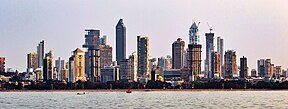
Back পশ্চিম ভারত Bengali/Bangla Oest de l'Índia Catalan Hindıstanê Rocawani DIQ Okcidenta Barato Esperanto Inde de l'Ouest French מערב הודו HE पश्चिमी भारत Hindi India occidentale Italian 西インド Japanese დასავლეთი ინდოეთი Georgian
Western India
West India | |
|---|---|
From top, left to right: Taj Hotel, Mumbai; Dudhsagar Falls; Wakaner Palace; Chatrapati Shivaji Terminus, Mumbai; New Palace, Kolhapur; Cola Beach, Goa; Mumbai skyline | |
 | |
| Country | India |
| States and territories | |
| Other states sometimes included | |
| Largest city | Mumbai |
| Most populous cities (2011) | |
| Area | |
• Total | 508,032 km2 (196,152 sq mi) |
| Population | |
• Total | 173,343,821 |
| • Density | 340/km2 (880/sq mi) |
| Time zone | IST (UTC+5:30) |
| Official languages | |
Western India is a loosely defined region of India consisting of western states of Republic of India. The Ministry of Home Affairs in its Western Zonal Council Administrative division includes the states of Goa, Gujarat, and Maharashtra along with the Union territory of Dadra and Nagar Haveli and Daman and Diu,[1] while the Ministry of Culture and some historians also include the state of Rajasthan.[2][3] The Geological Survey of India includes Maharashtra but excludes Rajasthan[4] whereas Ministry of Minority Affairs includes Karnataka but excludes Rajasthan.[5]
Madhya Pradesh is also often included[6][7][8] and Haryana, western Uttar Pradesh and southern Punjab are sometimes included.[9] Western India may also refer to the western half of India, i.e. all the states west of Delhi and Chennai, thus also including Punjab, Kerala and surrounding states.[10] The region is highly industrialised, with a large urban population.[11] Roughly, Western India is bounded by the Thar Desert in the north, the Vindhya Range in the east and north and the Arabian Sea in the west. A major portion of Western India shares the Thar Desert with North India and Pakistan and the Deccan Plateau with South and Central India.
In ancient history, Western India was divided into three great states according to Hwen Thsang, namely Sindh (which comprised the whole valley of the Indus from the Punjab to the sea, including the Delta and the island of Kutch), Gurjara (which comprised Western Rajputana and the Indian Desert), and Balabhi (which comprised the peninsula of Gujarat, with a small portion of the adjacent coast).[12] Before the partition of India, the now-Pakistani territories of Sindh and Balochistan were also included in this region. In art history, the term normally covers just Gujarat and Rajasthan, which tend to move together in terms of style.[13] Western India has the second-largest gross domestic product of any region in India.

- ^ "Inter-state Council Secretariat, Ministry of Home Affairs, Government of India". Retrieved 13 February 2018.
- ^ "West Zone Cultural Centre". wzccindia.com. Ministry of Culture, Government of India. Retrieved 13 February 2018.
- ^ Vidyarthi & Rai 1977.
- ^ "Geological Survey of India". Retrieved 13 February 2018.
- ^ "Report of the Commissioner for linguistic minorities: 52nd report (July 2014 to June 2015)" (PDF). Commissioner for Linguistic Minorities, Ministry of Minority Affairs, Government of India. Archived from the original (PDF) on 28 December 2017. Retrieved 31 August 2020.
- ^ Parthasarathy & Iyengar 2006, p. 85.
- ^ "West India - Madhya Pradesh". Asia-Planet.
- ^ Nilsen 2010, p. 205.
- ^ Pandeya & Lieth 2012, p. 219.
- ^ Rothermund 1993, pp. 190–193.
- ^ "Census GIS data". Retrieved 12 March 2008.
- ^ Cunningham 1871, p. 248.
- ^ Blurton, T. Richard, Hindu Art, p. 187, 1994, British Museum Press, ISBN 0 7141 1442 1; Michell, George (1990), The Penguin Guide to the Monuments of India, p.262, Volume 1: Buddhist, Jain, Hindu, 1990, Penguin Books, ISBN 0140081445






